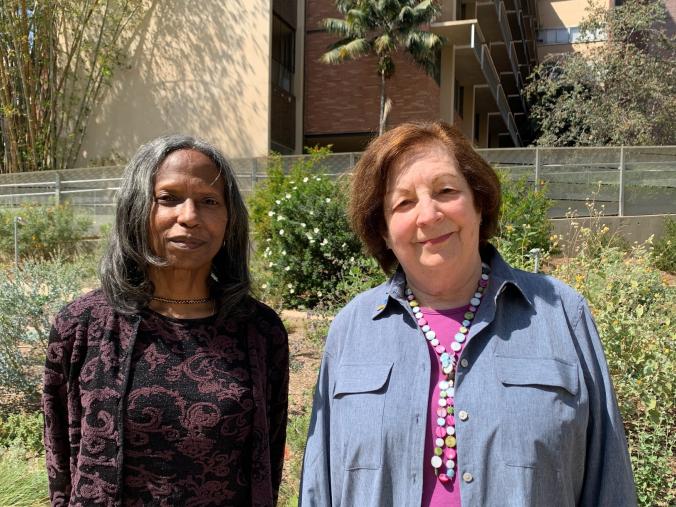A Combined 82 Years at the School: A Conversation with Dr. Carol Bibb & Ms. Francesca Moore

With a combined 82-year history at the School of Dentistry, you can imagine all of the challenges and changes seen by Dr. Carol Bibb and Ms. Francesca Moore over the decades. Two very different chance encounters led to their lifelong and fulfilling careers here in Westwood. In an insightful joint interview, we asked these extraordinary people what brought them here, what friendship and support from other women has meant to them, and what they hope to see next.
School of Dentistry: What brought you to the School, and when?
Francesca Moore: I started in 1990. At that time, I was teaching dental assistants. I wanted them to experience an orthodontics meeting and the camaraderie of being around other assistants, orthodontists and, you know, get the feel of what it is that they were going into as dental assistants. I met Dr. Spiro Chaconas at the Pacific Coast Society of Orthodontics meeting. One of my former co-workers, Phyllis Parker, was working with him and said they needed an orthodontic assistant. She introduced me to the doctor, and that was it!
Carol Bibb: I need to go back to about 1973. I had never thought about going into dentistry. I went to graduate school and got a Ph.D. in Biology and I was actually working in a basic science research lab that was in the dental school building at UCLA.
My quick story here, which brings tears to my eyes, is that I was sitting in my research lab working away and there was a knock on the door and it was Dr. Jean Savage, one of the few women on the dental school faculty at that time. She introduced herself and said the admissions committee had asked her to take me to lunch and talk about going to dental school. She explained that UCLA was actively trying to address the shortage of women in dentistry. I was in the class of 1978, which was about 20 percent women, so we were making progress.
I would not have gone to dental school and had an amazingly rewarding, satisfying career had it not been for a positive role model, who specifically reached out to me. I will never forget this personal interaction, and I have tried to follow Jean’s example in all that I do.
SOD: In addition to Dr. Jean Savage, I wonder if there are other women you want to mention here, that we can highlight for Women’s History Month.
Francesca: Dr. Clarice Law. She was a resident with me and then became a professor in pediatric dentistry and orthodontics. During a critical time for me, she was very supportive and I can't thank her enough. I also remember Dr. Elizabeth McNabb; she was the only female orthodontic resident in the program for a long time. She came back to mentor and teach. Dr. Vacharee Fell is another faculty member that always exemplified excellence. She still works with all of the residents to prepare them for the American Board of Orthodontics exam.
Carol: My early mentors and role models on the faculty were men, like Dr. Edmond Hewlett and Dr. Ron Mito. Later, and my colleagues and friends to this day, are women including Drs. Fariba Younai, Diana Messadi, Chris Quinn, Clarice Law, Evelyn Chung, Ting-Ling Chang, and Flavia Pirih. Over the years we have found each other for friendship and support.
SOD: Wonderful. It seems there was a slow and steady climb to get to where we are today through a lot of work, from the people that you mentioned and beyond. Thinking about the next, let's say five to 10 years, what are you hoping for? What are your dreams for the School?
Carol: I have devoted a lot of time to mentoring and encouraging future educators. This is where we have work to do to increase the diversity of our faculty and staff. We have a responsibility to pursue this goal because we all know that a diverse healthcare workforce improves healthcare outcomes.
Francesca: Yes, yesterday we had a patient in the clinic that had a concern. And they called me to come help with the concern. This morning, when I followed up to make sure everything was okay, that it was taken care of with the faculty and the resident, the patient said, “You know, I didn't realize that there were people that look like me here. I’ve come here several times and I don't see anyone that looks like me. I see a few dental students that look like me but I definitely don't see any faculty here.”
Carol: And we're working on it.
Francesca: And with our Hispanic patients, they say that they see all of these people at the front desk, helping, but not as doctors. Then I have to say, “Oh, you know, there is so-and-so but he’s here on a different day.”
Carol: Listening to Fran reminds me of when I was at the White Coat Ceremony many years ago, and the parents of an entering woman student came up to me at the reception and actually touched me on the shoulder and introduced themselves. I'll never forget what they said: “We are sending our daughter to your school, and we are so glad to see one woman on faculty.” In the end, it was obvious that they actually needed to physically see and touch me to make it real. We should celebrate how far we have come since that encounter and be inspired to continue our efforts.
SOD: I wish we could talk for hours because you're both touching upon such big items here, with the history of the School, your individual histories and experiences with the School, and how there's still work to be done in terms of equity and representation and how that resonates deeply with our patients. Thank you, both.
